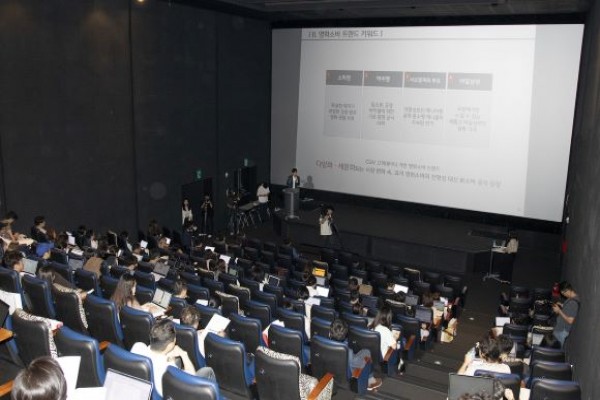130, Suyeonggangbyeon-daero,
Haeundae-gu, Busan, Republic of Korea,
48058
NEWS & REPORTS
3 Questions to Predict Korea’s Film Industry in 2023
- Writerby Kim Seonghoon, Bae Dongmi, Nam Sunwoo
- View2513
What film exhibitors can expect in 2023

2022 was the year of recovery. The film exhibition sector, which had collapsed owing to the Covid-19 pandemic, was finally given some time to recover, slowly but surely, starting with the lifting of social distancing rules. In that sense, 2023 should prove to be a trial by fire for Korean films, and to a greater extent, for the world film market. Covid-19 has now reached the endemic phase, and the growth in subscribers streaming services have been enjoying is now slowing down. In a way, you could say that the evil hands that bewitched the audience for the past three years have been stopped. And yet, concerns persist. It remains to be seen how the industry will be capable of adapting itself to this new paradigm. In order to have a rough idea, we have put together three questions that probe the shape the cinema industry will take in 2023 through the aspects of investment, distribution, production, and workforce.
Will Avatar: The Way of Water make waves in theaters?
Could it be that Avatar: The Way of Water will bring about a shift in the cinema landscape in the same way Avatar pushed theaters to upgrade their equipment to allow for 3D screenings in its time? To find out, it is essential to take into consideration factors such as the rising ticket prices and the rapid growth of streaming services.
“With ticket prices going up and the development of streaming services, audiences are now breaking up movies into those they will watch in theater and those they will watch at home”, said Hwang Jaehyeon, Head of Communication at Korea-based film exhibitor CJ CGV. This seems to go hand-in-hand with a certain propensity to favor premium screening rooms like those equipped with Dolby Atmos or 4DX technologies as well as movies that offer a unique experience that couldn’t be replicated at home. “The average occupancy rate of the 4DX cinemas that screened Avatar: The Way of Water is close to 90% [in the first week of its release], while that rate for IMAX theaters is close to 80%”, Hwang explained. “An occupancy rate hovering between 80 and 90% basically means that if you don’t take into account the early and late night screenings, the film has been essentially screening to a full house.” Film exhibitors are taking a lot of interest in such changes in audience behaviors. Lee Shinyoung, Head of Communication at Lotte Cultureworks, also says that “investment in premium theaters will have to be constant if we want to follow the ever-changing purposes people might have for the moviegoing experience.”
However, setting up a premium screen comes at no small cost. One strategy that exhibitors might want to consider for the long run is to ‘position’ themselves as ‘premium screen hubs’. This consists in establishing a ‘flagship premium screen” in busy venues or neighborhoods, like CGV did by setting up an IMAX screen at Yongsan I'Park Mall, which film afficionados now call 'Yong I’mak'. Another pretty similar example is the CGV multiplex in Daegu, which had the only IMAX screen in the city. It closed in 2021 and reopened recently, at the end of 2022. Lee Hayoung, former Head of distribution at Cinema Service and current CEO of Haha Films, published the book <Film Distribution and Success>. He predicts, “Exhibitors will reduce the number of normal 2D screens and increase instead the number of premium screens.” Some of these normal theaters at CGV Piccadilly 1958 and CGV Guro multiplexes have already been turned into indoor climbing gyms after the screens and seats were taken away.
But does it necessarily mean that there will be more theaters equipped with 3D screening technology after the commercial success of Avatar: The Way of Water? It's difficult to know for sure. “There was a surprise boom with the first Avatar movie, but not many 3D movies were produced after that”, said Lee Hayoung. Exhibitors could see clearly 13 years ago that 3D movies will never take off, so there doesn’t seem to be any reason to rush to invest in 3D screening setups.

Oppenheimer, Universal Pictures

The Marvels, Walt Disney Company Korea

Mission: Impossible – Dead Reckoning Part One, Lotte Entertainment
Marvel and Christopher Nolan are set to dominate the summer box office, but what about Korean movies?
Along with the Korean holidays, summer is one of the peak seasons for Korea’s box office. Will it live up to its potential in 2023? In the summer of 2022, the market drew much notice as it saw a weekly drip of highly anticipated releases, but criticism also mounted as a result since it left little room for other titles to compete. This summer, the competition between distributors is expected to intensify. Major foreign titles are already lining up for theatrical release between July and August.
Most notable among them is Christopher Nolan's latest, Oppenheimer (distributed by Universal Pictures). Nolan scored a win by releasing Tenet when the pandemic was reaching its peak in August 2020, with the film performing relatively well as it drew in 2 million viewers in Korea. Marvel has been putting up a good fight as it could rely as always on its fandom in these difficult times and isn’t about to pull any punches this summer. A lot has been said about actor Park Seojoon’s participation in The Marvels (distributed by The Walt Disney Company Korea), which is about to land in July, and the company also plans to release in 2023 Ant-Man and the Wasp: Quantumania and Guardians of the Galaxy Volume 3. After demonstrating his prowess in Top Gun: Maverick last year, Tom Cruise will visit Korea again with Mission: Impossible: Dead Reckoning Part One (distributed by Lotte Entertainment), which is also aiming for a summer release.
With the situation being what it is, Korean films don’t seem eager to set their sights on the summer season. A strong contender can be found in Director Kang Jekyu's Road to Boston (distributed by Lotte Entertainment), which was initially set to release in 2022. It will be followed by Ryoo Seungwan’s Smugglers (distribution NEW), which has just completed production, <Kidnapped (translated title)> (distributed by Showbox) directed by Kim Seonghun, and <Noryang: The Sea of Death (translated title)> directed by Kim Hanmin (distributed by Lotte Entertainment). It remains to be seen whether the second part of Alienoid (distributed by CJ ENM) will be released this summer, since the first part underperformed. Making hasty judgments this early into the year would be ill-advised, but it is becoming clear that for Korean films to hold their own this summer season they will need a distribution strategy that anticipates the ripple effect caused by these international blockbusters drawing massive crowds, rather than face them head-on.

Are investments in new productions and the expenses of film studios shrinking?
CJ ENM (CEO Koo Changgun) underwent a major reorganization at the start of the year. Jerry Kyoungboum Ko, former Head of the International film department who notably spearheaded the Oscar race for <Parasite>, has been appointed as the new Head of Film Division. Behind that simple nomination, the biggest change is the fact that the company’s whole film business has been reduced from a department to a division. The Investment subdivision (led by Lee Sunyoung), which was operating as three distinct units, has been consolidated into one. The planning and production subdivision (Lim Lee Ji-young) was also operating as three units; one of them is now under CJ Studios (CEO JK Youn), and the other two have been merged into a single one. The domestic distribution and overseas distribution units were also integrated into a unified distribution unit. A CJ ENM official explained, “We made the general structure more compact by consolidating the planning department and the production department, which used to have up to six units in charge of investment or production”. This follows another major reorganization that was carried out in October of last year, when 10 board members were asked to resign and the CEO of CJ affiliate Olive Young, Koo Changgun, born in 1973, was nominated as the new CEO of CJ ENM.
The atmosphere at CJ around the end of last year was so tense that the idea that you could hear within and outside of the conglomerate that “the objective was to reduce the workforce by 50%” (according to an unnamed producer). According to a CJ ENM official, “There were as many as six teams with overlapping responsibilities (ie. planning and production), and with the CEO seat being vacant, the hierarchy became looser since the unit heads suddenly had more power”. Many are of the opinion that this reorganization is an answer to some extent to these concerns. It should come as no surprise that a producer within the company revealed that, “Considering that our competitor Showbox has about 30 employees, CJ ENM with its 100+ employees is indeed a large organization. It is already difficult to make predictions in an economic context such as the one we are currently in, but it is really tough for a large organization to proactively respond to external changes when the content industry is evolving so fast.” Someone else confided, "The biggest change isn’t the appointment of new executives but the fact that the status of CJ Entertainment has been downgraded to that of an affiliated unit under CJ Studios." This is cause for some concerns: “Now CJ ENM finds itself at the same hierarchical level as those very same producers and directors working for CJ Studios that they would supervise in the past. This will make it more difficult to create a systematic process of production management.” We will have to wait and see a bit longer to determine with certitude whether the purpose of this new direction engaged with these nominations and restructuration was the systematization of the marketing and distribution sector or was for the benefits of the creators.
That CJ made such a decision is not irrelevant to the larger trend of considerable reduction in investment in new film projects, which naturally resulted to film distributors gradually reducing their operating costs. This is largely due to the fact that with a long backlog of titles having yet to find the right window for a theatrical release, investors are less keen to back a lineup of new movies than before. As the industry restructured itself around streaming services, film investment and distribution companies found themselves in a challenging situation in which they had to plan and produce series on top of their usual slates of films. To make things worse, as interest rates have risen due to the recent global economic crisis, movies do not offer anymore guarantees of huge returns for investors like venture capital firms. It is expected that investment and distributing companies will continue to keep a close eye on the industry for the time being as they maintain their operations at a reduced level.














